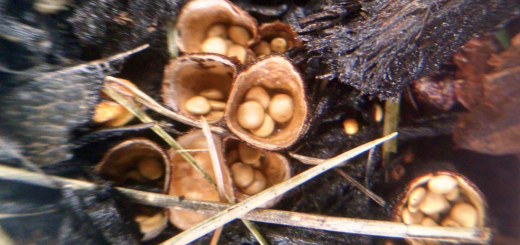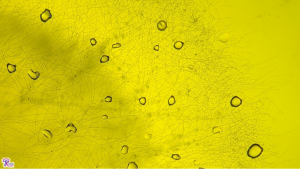#113: Moniliophthora perniciosa, Witches’ Broom Disease of Cacao Trees
Witches might not be real, but witches’ brooms certainly are – and they’re destroying chocolate! Yes, Halloween’s favorite treat (chocolate) is suffering at the hands of a disease with a Halloween-themed name: Witches’ Broom Disease. Witches’ brooms are actually fairly common and occur on many different plants. In chocolate trees (Cacao trees, Theobroma cacao, whose genus name literally means “food of the gods”), witches’ brooms are caused by the fungal pathogen Moniliophthora perniciosa and have an enormous economic impact on chocolate production in Central and South America.
Witches’ brooms are abnormally dense growths of branches in trees. Instead of following a normal branching pattern, a branch forming a witches’ broom will send out many new shoots from the same point. These new shoots branch frequently, creating a messy tangle of branches. The resulting structure is known as a witches’ broom because the unruly tangles look like something a witch might use for a broom. Not only is this structure unsightly, but it is inefficient for trapping light and therefore is a net drain on the plant’s resources. Witches’ brooms appear on many different trees and shrubs and have a variety of causes. Causal agents of witches’ brooms include: fungi, genetic mutations, mites, dwarf mistletoe, phytoplasmas, and certain environmental conditions.
Witches’ Broom Disease (WBD) of Cacao Trees (Theobroma cacao) is caused by the fungus Moniliophthora perniciosa. This fungus is closely related to Moniliophthora roreri, which causes Frosty Pod Rot of Cacao (FFF#068). Despite their close relationship, the two fungi have different disease cycles and reproductive methods. I will cover only M. perniciosa here, so for more on Frosty Pod Rot, see my earlier post.
The life cycle of M. perniciosa begins when a spore (haploid, i.e. one set of chromosomes) lands on a susceptible part of a cacao tree. When there is high humidity, the spore germinates and starts producing hyphae (strings of fungal cells). The hyphae enter the actively-growing branch, flower, or young fruit of a tree through unhardened tissue, a naturally-occurring pore, or a wound. At this point, the fungus may form thick-walled resting spores inside the plant. The purpose of these spores is not known, but they may indicate the presence of a dormant phase between initial infection of the plant and when the fungus begins its parasitic activities. Once inside the tree, the fungus attacks the plant cells and alters normal development. During this process, the fungus produces infective hyphae that contain 1-10 nuclei per cell. These nuclei are all identical, so the fungus is still considered to be haploid.
If the fungus infected a stem, the tree will form a witches’ broom. At this point, the new shoots can still grow and produce leaves, so the structure is known as a “green broom.” After one to two months, the fungus chokes off the new growth, which dries out and turns brown to create a “dry broom.” Dry brooms remain attached to the tree’s branches.
If the fungus entered the plant through a flower, the plant may grow cushion brooms (brooms composed of small shoots where the flowers are supposed to be) or produce parthenocarpic fruit. Parthenocarpy is the process by which plants form fruit without being pollinated. This process does not produce viable seeds, which is important for any seedless variety of fruit (e.g. grapes, bananas, watermelon). However, chocolate is made from the seeds of the Cacao tree, so parthenocarpic Cacao seed pods are useless.
If the fungus infected a seed pod, the pod will rot and die. Pods infected during the first few weeks of development will remain small and not produce any seeds. Young pods that were infected a bit later will still grow, but the fungus will spread through the entire pod by maturity (about six months) and cause a complete loss of seeds. In pods that were older when infected, the fungus may leave some seeds untouched.
At some point, the haploid mycelium (network of hyphae) encounters another haploid mycelium of M. perniciosa. If the two individuals are compatible with each other, the hyphae fuse to form a dikaryotic mycelium. Now the fungus has two sets of chromosomes. The main strain of M. perniciosa is self-fertile, so the chromosome sets may be from the same or different parents. Each set of chromosomes is kept in its own nucleus, thus the mycelium is dikaryotic instead of diploid (two sets of chromosomes in the same nucleus). In the dikaryotic mycelium, each cell has exactly one nucleus from each original, haploid mycelium.
Upon formation of a dikaryotic mycelium, the fungus switches from a parasitic strategy to a saprobic one. Instead of attacking living plant cells, the fungus begins decomposing dead tissue. Since M. perniciosa had previously caused the formation of dry brooms or substantially rotted a seed pod, there is plenty of necrotic tissue for it to decompose. Once it has decomposed enough tissue, the fungus is ready to produce mushrooms. Its tiny, pink, gilled, umbrella-like mushrooms appear during the rainy season after successive bouts of wet and dry weather. These mushrooms produce sexual spores (after meiosis, each spore is haploid and contains genes from both parents) that are dispersed by the wind. M. perniciosa belongs to the phylum Basidioimycota, class Agaricomycetes, order Agaricales, and family Marasmiaceae. The mushrooms produced by M. perniciosa are very characteristic of the fungi in the Marasmiaceae.
WBD usually does not kill Cacao trees. It does, however, divert resources into unnecessary growth. This means that trees have less food available for developing pods. Even without attacking the fruits themselves, WBD would cause a decrease in seed production. WBD does infect seed pods, so seed production is decreased in two separate ways. Additionally, heavy infestations can kill trees. If a tree has too many brooms, it won’t have enough resources to produce functional, long-lasting leaves. In this case, the disease will use up all the tree’s food and the tree will die. Even mild infections can make trees more susceptible to death resulting from other factors, such as drought, wind, and other diseases.
M. perniciosa evolved east of the Andes in the Upper Amazon River basin, where its host plants also originated. Witches’ Broom Disease can infect a number of species, including: Theobroma species, Herrania species (which are close relatives of Theobroma), a variety of plants in the Solanaceae (the Nightshade family, which includes potatoes, tomatoes, chilies, and others), and Arrabidaea verrucosa. There are three biotypes (strains) of M. perniciosa – designated C, L, and S – each specializing in a different group of hosts. A fourth biotype (H, infecting Heteropterys auctifolia) was found to be genetically different enough from the other biotypes to be classified as its own species (Crinipellis brasiliensis). The most important of these groups is the C biotype, which infects Theobroma and Herrania species, including T. cacao.
Witches’ Brooms Disease was first described on T. cacao in Amazonia in the 1780’s. This was only a problem for native trees until 1895, when it appeared on cultivated trees in Surinam (at that time Dutch Guyana). Soon after that, the disease spread to Guyana by 1906, Ecuador by 1918, Trinidad by 1928, Columbia by 1929, and Grenada by 1948. Production in Ecuador, which was at that time the world’s top exporter of cocoa, dropped by over 50% in less than ten years. Other countries had similar or worse experiences: WBD tends to cut production by 50-90%. The rapid spread of the fungus was likely human-mediated. Transportation of infected pods by migrating farmers is probably the primary means by which WBD spread to the western side of the Andes. Brazil’s main chocolate-producing region remained disease-free until 1989, when the fungus made its way to Bahia (on the eastern tip of Brazil). Following this, Brazil production dropped about 70%, taking the country from being the third largest exporter of chocolate to being a net importer. The main reason for such a drastic decrease in production was that there was almost no genetic variation among Bahia’s Cacao trees. This is just one more example of how dangerous the practice of monoculture can be. Today, WBD’s range is still limited to Central and South America. Although the disease does cause great losses of seeds in countries within its range, chocolate production continues unabated thanks to production in uninfected areas in Southeast Asia and West Africa.
WBD is an exceptionally difficult disease to control. Fungicides are not practical in most places and cannot be used in areas that experience high rainfall. The disease can be partially controlled by pruning back brooms, but this labor-intensive strategy is often not cost-effective. A few disease-resistant varieties of T. cacao have been identified, but these are often not as flavorful. Unfortunately, although resistant varieties do not form brooms, they are still susceptible to pod rot by M. perniciosa. Another control mechanism that is being developed is the use of endophytic fungi! Fungal endophytes are fungi that live inside of plant tissues. Many of these do not cause the plant any harm and some even benefit their host plants (for more, see FFF#115). In the case of T. cacao, it is hoped that trees inoculated with the fungal endophyte Trichoderma stromaticum will be resistant to WBD. T. stromaticum is parasitic on the mycelium of M. perniciosa, so this biological control strategy could provide Cacao trees with lifelong immunity to WBD. More recently, scientists have been working to identify all the genes that are active in M. perniciosa during the infection process. It is hoped that understanding the molecular mechanisms behind WBD will lead to new ways to treat the disease.
Chocolate is both an economically and ecologically important crop. It provides millions of people with a livelihood, but it also protects rainforest diversity. Cacao is an understory tree, so it grows well in shade. As a result, chocolate plantations often conserve the upper rainforest canopy, which provides homes to many animals, plants, and other species. It is difficult to apply fungicides in this environment, so farmers who opt for chemical control of WBD usually cut down the canopy. Additionally, if a cacao farm fails, it is often converted into a farm for shade-intolerant crops, which also gets rid of the canopy. WBD is thus having a negative impact on the ecology as well as the economy of infected countries.
See Further:
http://worldcocoafoundation.org/wp-content/files_mf/meinhardt2008.pdf
http://users.aber.ac.uk/gwg/pdf/griffith-wbdbiologist.pdf
http://agresearchmag.ars.usda.gov/1999/nov/cacao
http://www.ncbi.nlm.nih.gov/pubmed/19018989
http://phys.org/news/2014-10-scientists-devastating-witches-broom-disease.html








![#011: Characteristics of Kingdom Fungi [Archived]](https://www.fungusfactfriday.com/wp-content/themes/hueman/assets/front/img/thumb-small-empty.png)


1 Response
[…] M. roreri and another cacao disease, Crinipellis perniciosa (Witch’s Broom Disease of cacao, FFF#113). The two cacao pathogens produce similar infection structures, have a similar hyphal morphology, […]